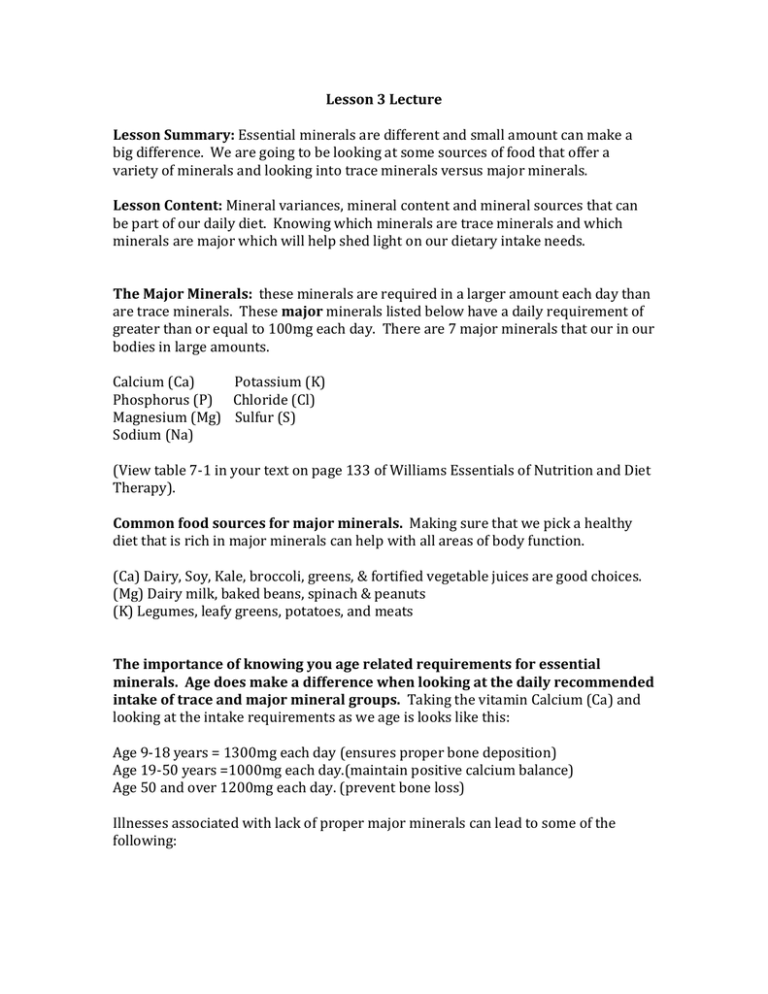JFabreHW499Unit3LectureNotes
advertisement

Lesson 3 Lecture Lesson Summary: Essential minerals are different and small amount can make a big difference. We are going to be looking at some sources of food that offer a variety of minerals and looking into trace minerals versus major minerals. Lesson Content: Mineral variances, mineral content and mineral sources that can be part of our daily diet. Knowing which minerals are trace minerals and which minerals are major which will help shed light on our dietary intake needs. The Major Minerals: these minerals are required in a larger amount each day than are trace minerals. These major minerals listed below have a daily requirement of greater than or equal to 100mg each day. There are 7 major minerals that our in our bodies in large amounts. Calcium (Ca) Potassium (K) Phosphorus (P) Chloride (Cl) Magnesium (Mg) Sulfur (S) Sodium (Na) (View table 7-1 in your text on page 133 of Williams Essentials of Nutrition and Diet Therapy). Common food sources for major minerals. Making sure that we pick a healthy diet that is rich in major minerals can help with all areas of body function. (Ca) Dairy, Soy, Kale, broccoli, greens, & fortified vegetable juices are good choices. (Mg) Dairy milk, baked beans, spinach & peanuts (K) Legumes, leafy greens, potatoes, and meats The importance of knowing you age related requirements for essential minerals. Age does make a difference when looking at the daily recommended intake of trace and major mineral groups. Taking the vitamin Calcium (Ca) and looking at the intake requirements as we age is looks like this: Age 9-18 years = 1300mg each day (ensures proper bone deposition) Age 19-50 years =1000mg each day.(maintain positive calcium balance) Age 50 and over 1200mg each day. (prevent bone loss) Illnesses associated with lack of proper major minerals can lead to some of the following: As the requirements for each mineral changes so does our body. It is important to try and get these resources from food when possible. Supplementation is also a common practice, however making sure we stay within the Upper Tolerable Intake level is kEY. Trace Minerals: these minerals are not required each day in larger amounts such as the Major Minerals. The requirement for the trace minerals listed below require less than 100mg each day. These amounts are considered trace but they are essential for human body functions. Iron (Fe) Chromium (Cr) Iodine (I) Cobalt (Co) Zinc (Zn) Selenium (Se) Copper (Cu) Molybdenum (Mo) Manganese (Mn) Flouride (F) (View Table 7-1 in your text on page 133 of Williams Essentials of Nutrition and Diet Therapy). Common food sources of a few of the following trace minerals: (Fe) Chicken, ham, eggs, peas, prune juice, raisings, white bread and tuna (I) Seafood, commercially processed bread and table salt (Z) Oysters, eggs, legumes, meat and whole grains The importance of knowing you age related requirements for essential minerals. Age does make a difference when looking at the daily recommended intake of trace and major mineral groups. Zinc – DRI for men = 11mg each day DRI for women = 8mg each day Common deficiencies from lack of trace minerals are as follows: Goiter – Iodine deficiency - pg. 154 of text. Iron deficiency Anemia & Iron toxicity or Hemochromatosis pg. 152 of text. Hypogonadism – zinc insufficiency pg. 155 of text. **Food sources of Major & Trace minerals self note: because these simple organic elements are seldom lost in cooking they are so wonderfully stored in our food. Simple ways of getting some major minerals are as easy a consuming some of our favorite foods. Taking a look at some of these common foods and their mineral content can help up make smart decisions when purchasing you weekly groceries. NOTE ABOUT DIET GET CREATIVE IN PLANNING YOUR DIET BECAUSE WE CAN GET MANY MINERALS FROM ONE SOURCE OF FOOD. Play with a menu creating meal plan for one week. Dairy products can give you (P) & (Ca) while leafy greens can give you (Ca) & (Mg).







